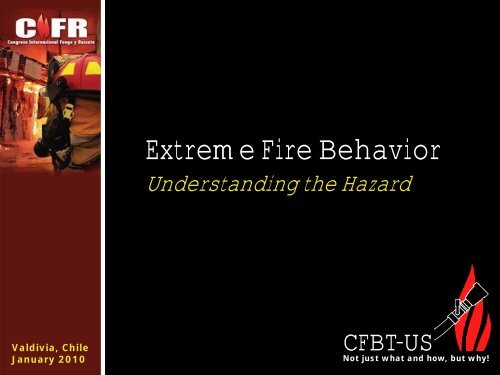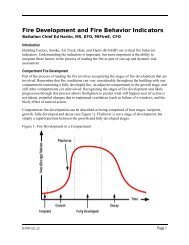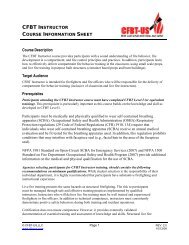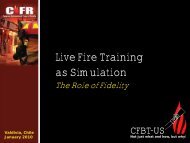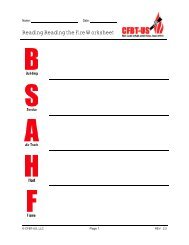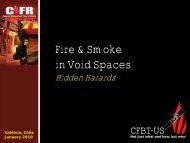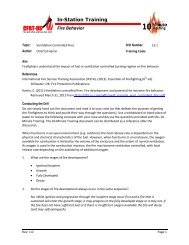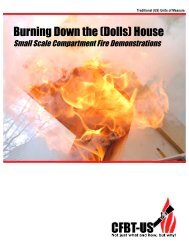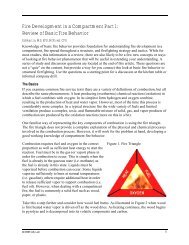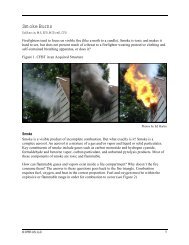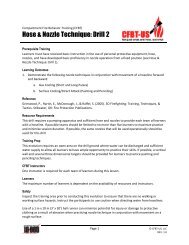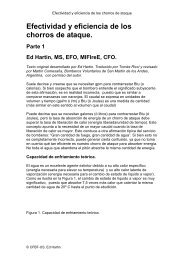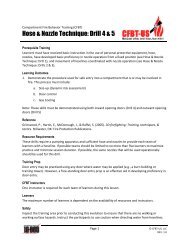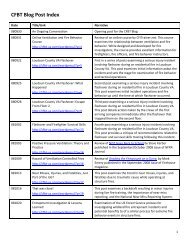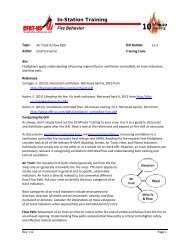Extreme Fire Behavior: Understanding the Hazard - CFBT-US!
Extreme Fire Behavior: Understanding the Hazard - CFBT-US!
Extreme Fire Behavior: Understanding the Hazard - CFBT-US!
You also want an ePaper? Increase the reach of your titles
YUMPU automatically turns print PDFs into web optimized ePapers that Google loves.
Valdivia, Chile<br />
January 2010<br />
<strong>Extreme</strong> <strong>Fire</strong> <strong>Behavior</strong><br />
<strong>Understanding</strong> <strong>the</strong> <strong>Hazard</strong><br />
<strong>CFBT</strong>-<strong>US</strong><br />
Not just what and how, but why!
For what is experienced judgment except<br />
opinion based on knowledge acquired by<br />
experience? If you have fought fires in<br />
every type of building with every different<br />
configuration and fuel load, under all types<br />
of conditions, and if you have remembered<br />
exactly what happened in each of <strong>the</strong>se<br />
combinations your experienced judgment is<br />
probably very good.<br />
Paraphrased from<br />
Fundamentals of <strong>Fire</strong> <strong>Behavior</strong><br />
Gisborne, 1948
Learning Outcomes<br />
Recognize <strong>the</strong> hazards presented by extreme<br />
fire behavior.<br />
Explain how <strong>the</strong> following extreme fire<br />
behavior phenomena occur:<br />
Flashover<br />
Backdraft<br />
Smoke Explosion<br />
Flash <strong>Fire</strong>
<strong>Extreme</strong> <strong>Fire</strong> <strong>Behavior</strong><br />
Rapid transition and<br />
sustained increase in HRR<br />
Ignition and rapid or<br />
explosive combustion<br />
Fuel<br />
Controlled<br />
Step Events<br />
Flashover<br />
Ventilation<br />
Controlled<br />
Vent-Induced<br />
Flashover<br />
Moderate Fuel/Air<br />
Concentration<br />
HRR Sufficient to Result in<br />
Full Surface Involvement<br />
Phenomena that result in rapid<br />
fire progression and present a<br />
significant threat to firefighters<br />
Transient Events<br />
Smoke<br />
Explosion<br />
Overpressure<br />
Confined<br />
Pre-Mixed<br />
Flammable<br />
Fuel/Air Concentration<br />
Flash<br />
<strong>Fire</strong><br />
High Fuel/Air<br />
Concentration<br />
Pre-Mixed Flammable<br />
Fuel/Air Concentration<br />
Limited Mass or Confinement<br />
Minimal<br />
Overpressure<br />
Backdraft
Knowledge and Skill<br />
What knowledge and skill becomes critical to<br />
your safety when faced with <strong>the</strong>se conditions?
HRR<br />
A<br />
B<br />
C<br />
Time<br />
D
Flashover<br />
Flashover is a rapid transition to <strong>the</strong> fully<br />
developed stage of a compartment fire.<br />
Heat flux increases <strong>the</strong> temperature of<br />
additional fuel packages within <strong>the</strong><br />
compartment.<br />
Sufficient transfer of heat to o<strong>the</strong>r fuel<br />
packages can result in flashover<br />
Radiant Heat Flux at <strong>the</strong> Floor: 15-20 kW/m2 Temperature: 500o-600o C (932o-1112o F)
HRR<br />
A<br />
B<br />
C<br />
E<br />
Time<br />
D
Flashover<br />
Given adequate ventilation flashover occurs<br />
as part of normal fire development<br />
If ventilation is limited, <strong>the</strong> fire may become<br />
ventilation controlled prior to flashover<br />
A subsequent increase in ventilation may<br />
result in flashover
HRR<br />
A<br />
B<br />
C<br />
E<br />
Time<br />
D<br />
F
Activity<br />
Vent Induced Flashover<br />
These video clips show recreation of<br />
conditions involved in <strong>the</strong> fatality of<br />
two firefighters involved in a live<br />
fire training exercise.<br />
Fuel load included pallets, a<br />
polyurethane foam mattress, carpet,<br />
and carpet padding.<br />
Describe your observations and<br />
explain <strong>the</strong> observed phenomena<br />
Ano<strong>the</strong>r view…
Flashover<br />
Fuel-<br />
Controlled<br />
<strong>Fire</strong><br />
Adequate<br />
Air<br />
Increased<br />
HRR<br />
Adequate<br />
Fuel<br />
Additional<br />
Fuel
Flashover<br />
Vent-<br />
Controlled<br />
<strong>Fire</strong><br />
Fuel-<br />
Controlled<br />
<strong>Fire</strong><br />
Limited<br />
Air<br />
Adequate<br />
Air<br />
Increased<br />
HRR<br />
Adequate<br />
Fuel<br />
Additional<br />
Fuel<br />
Adequate<br />
Fuel<br />
Increased<br />
Ventilation<br />
Low<br />
Oxygen<br />
Concentration<br />
Increased<br />
HRR
Backdraft<br />
Backdraft is where an under-ventilated fire<br />
receives a sudden supply of air, and an ignition<br />
source causes <strong>the</strong> mixing fire gases to ignite,<br />
sometimes with explosive force<br />
Backdraft generally results in an extremely<br />
rapid, but transient increase in energy release.
HRR<br />
A<br />
B<br />
C<br />
E<br />
Time<br />
D<br />
F
Activity<br />
Backdraft<br />
This video clip illustrates a<br />
backdraft in a window cell.<br />
Watch closely for fire<br />
behavior indicators that may<br />
point to backdraft potential<br />
Why do you think <strong>the</strong>re is a<br />
difference in outcome in this<br />
series of demonstrations?
Backdraft<br />
Vent-<br />
Controlled<br />
<strong>Fire</strong><br />
Possibly<br />
High<br />
Temperature<br />
Increased<br />
Ventilation<br />
Limited<br />
Air Low<br />
Oxygen<br />
Concentration<br />
Excess<br />
Fuel<br />
Auto or<br />
Piloted Ignition<br />
High<br />
Fuel Gas<br />
Concentration
HRR<br />
Ventilation Increased<br />
Time<br />
Flashover or<br />
Backdraft?
Sequential Effects<br />
Transient fire behavior in and of<br />
itself does not generally result in a<br />
sustained increase in fire intensity.<br />
However…
Sequential Effects<br />
<strong>Fire</strong> in <strong>the</strong> basement of a<br />
five-story, heavy timber<br />
meat packing plant<br />
Yellowish brown smoke pushing<br />
with high velocity from floor<br />
four<br />
A backdraft followed horizontal<br />
ventilation of floor four<br />
Flashover of all floors lead to<br />
full involvement with extension<br />
to o<strong>the</strong>r buildings
Smoke Explosion<br />
Smoke Explosion involves ignition of an<br />
accumulated mass of flammable fire gases<br />
and pyrolysis products existing in a room or<br />
compartment<br />
The ignition source may be flames, embers,<br />
or may even be unrelated to <strong>the</strong> fire.<br />
Addition of oxygen is not necessary as <strong>the</strong><br />
gases already mixed with air and within <strong>the</strong>ir<br />
flammable range<br />
A smoke explosion is similar to<br />
ignition of propane or natural<br />
gas inside a structure
Smoke<br />
Explosion<br />
Gases < ±600 o C<br />
Low<br />
Temperature<br />
Adequate<br />
Air<br />
Adequate<br />
Fuel<br />
Within <strong>the</strong><br />
Flammable<br />
Range<br />
Piloted Ignition<br />
Ignition<br />
Source
Flash <strong>Fire</strong><br />
Flash fire involves ignition of accumulated<br />
pyrolysis products and flammable products of<br />
combustion<br />
The mass of gas phase fuel or confinement is<br />
limited, minimizing <strong>the</strong> overpressure resulting<br />
from combustion
Conditions are dynamic and<br />
may vary considerably at<br />
different locations in a building!<br />
Post-<strong>Fire</strong><br />
Control<br />
Within<br />
Flammable<br />
Range<br />
Ignition<br />
Source<br />
Initiating<br />
Event?<br />
Remote<br />
Location<br />
Low Temp<br />
Adequate<br />
Fuel<br />
Adequate<br />
Air<br />
Temporary<br />
Increase<br />
Smoke<br />
Explosion<br />
Ventilation-<br />
Controlled<br />
<strong>Extreme</strong><br />
<strong>Fire</strong> <strong>Behavior</strong><br />
Transient<br />
Event<br />
Backdraft<br />
Excess<br />
Fuel<br />
Increased<br />
Ventilation<br />
High Temp<br />
Sustained<br />
Increase<br />
Initiating<br />
Event<br />
Initiating<br />
Event?<br />
Step<br />
Event<br />
Changed<br />
Conditions<br />
Inadequate<br />
Air<br />
Above<br />
UEL/UFL<br />
Ventilation<br />
HRR<br />
Flashover<br />
Thermal<br />
Runaway<br />
Ventilation-<br />
Controlled<br />
<strong>Fire</strong><br />
Increased<br />
Ventilation<br />
Adequate<br />
Air Supply<br />
Fuel-<br />
Controlled<br />
<strong>Fire</strong><br />
Increasing<br />
HRR<br />
Additional<br />
Fuel<br />
Adequate<br />
Fuel<br />
Initiating<br />
Event?<br />
Increasing<br />
HRR<br />
Adequate<br />
Fuel<br />
Initiating<br />
Event?
<strong>Extreme</strong> <strong>Fire</strong> <strong>Behavior</strong><br />
Rapid transition and<br />
sustained increase in HRR<br />
Ignition and rapid or<br />
explosive combustion<br />
Fuel<br />
Controlled<br />
Step Events<br />
Flashover<br />
Ventilation<br />
Controlled<br />
Vent-Induced<br />
Flashover<br />
Moderate Fuel/Air<br />
Concentration<br />
HRR Sufficient to Result in<br />
Full Surface Involvement<br />
Phenomena that result in rapid<br />
fire progression and present a<br />
significant threat to firefighters<br />
Transient Events<br />
Smoke<br />
Explosion<br />
Overpressure<br />
Confined<br />
Pre-Mixed<br />
Flammable<br />
Fuel/Air Concentration<br />
Flash<br />
<strong>Fire</strong><br />
High Fuel/Air<br />
Concentration<br />
Pre-Mixed<br />
Fuel/Air Concentration<br />
Limited Mass or Confinement<br />
Minimal<br />
Overpressure<br />
Backdraft
ed.hartin@cfbt-us.com<br />
1 (503) 793-1296<br />
http://www.cfbt-us.com


